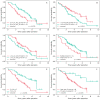Improving HCC Prognostic Models after Liver Resection by AI-Extracted Tissue Fiber Framework Analytics
- PMID: 38201532
- PMCID: PMC10778366
- DOI: 10.3390/cancers16010106
Improving HCC Prognostic Models after Liver Resection by AI-Extracted Tissue Fiber Framework Analytics
Abstract
Despite advances in diagnostic and treatment technologies, predicting outcomes of patients with hepatocellular carcinoma (HCC) remains a challenge. Prognostic models are further obscured by the variable impact of the tumor properties and the remaining liver parenchyma, often affected by cirrhosis or non-alcoholic fatty liver disease that tend to precede HCC. This study investigated the prognostic value of reticulin and collagen microarchitecture in liver resection samples. We analyzed 105 scanned tissue sections that were stained using a Gordon and Sweet's silver impregnation protocol combined with Picric Acid-Sirius Red. A convolutional neural network was utilized to segment the red-staining collagen and black linear reticulin strands, generating a detailed map of the fiber structure within the HCC and adjacent liver tissue. Subsequent hexagonal grid subsampling coupled with automated epithelial edge detection and computational fiber morphometry provided the foundation for region-specific tissue analysis. Two penalized Cox regression models using LASSO achieved a concordance index (C-index) greater than 0.7. These models incorporated variables such as patient age, tumor multifocality, and fiber-derived features from the epithelial edge in both the tumor and liver compartments. The prognostic value at the tumor edge was derived from the reticulin structure, while collagen characteristics were significant at the epithelial edge of peritumoral liver. The prognostic performance of these models was superior to models solely reliant on conventional clinicopathologic parameters, highlighting the utility of AI-extracted microarchitectural features for the management of HCC.
Keywords: CNN; artificial intelligence; digital pathology; hepatocellular carcinoma; hexagonal grid; liver; overall survival; prognostic modelling.
Conflict of interest statement
The authors declare no conflicts of interest.
Figures





Similar articles
-
Artificial intelligence-based reticulin proportionate area - a novel histological outcome predictor in hepatocellular carcinoma.Histopathology. 2023 Oct;83(4):512-525. doi: 10.1111/his.15001. Epub 2023 Jun 30. Histopathology. 2023. PMID: 37387193
-
Prognostic role of artificial intelligence among patients with hepatocellular cancer: A systematic review.World J Gastroenterol. 2020 Nov 14;26(42):6679-6688. doi: 10.3748/wjg.v26.i42.6679. World J Gastroenterol. 2020. PMID: 33268955 Free PMC article.
-
Prognostic Value of CD8+ Lymphocytes in Hepatocellular Carcinoma and Perineoplastic Parenchyma Assessed by Interface Density Profiles in Liver Resection Samples.Cancers (Basel). 2023 Jan 5;15(2):366. doi: 10.3390/cancers15020366. Cancers (Basel). 2023. PMID: 36672317 Free PMC article.
-
Automated fibrosis phenotyping of liver tissue from non-tumor lesions of patients with and without hepatocellular carcinoma after liver transplantation for non-alcoholic fatty liver disease.Hepatol Int. 2022 Jun;16(3):555-561. doi: 10.1007/s12072-022-10340-9. Epub 2022 May 13. Hepatol Int. 2022. PMID: 35553006
-
Artificial intelligence in the detection, characterisation and prediction of hepatocellular carcinoma: a narrative review.Transl Gastroenterol Hepatol. 2022 Oct 25;7:41. doi: 10.21037/tgh-20-242. eCollection 2022. Transl Gastroenterol Hepatol. 2022. PMID: 36300146 Free PMC article. Review.
References
-
- Eswaran S.L., Reau N.S. Hepatocellular Carcinoma: 5 Things to Know. [(accessed on 15 September 2023)]. Available online: https://www.medscape.com/viewarticle/925146?form=fpf.
Grants and funding
LinkOut - more resources
Full Text Sources

